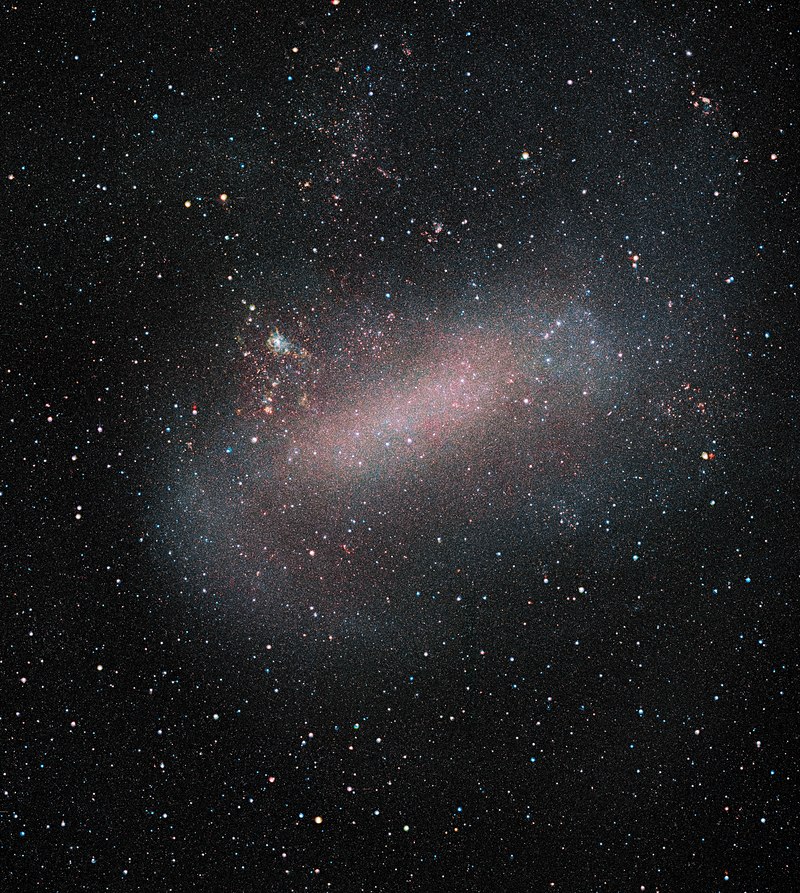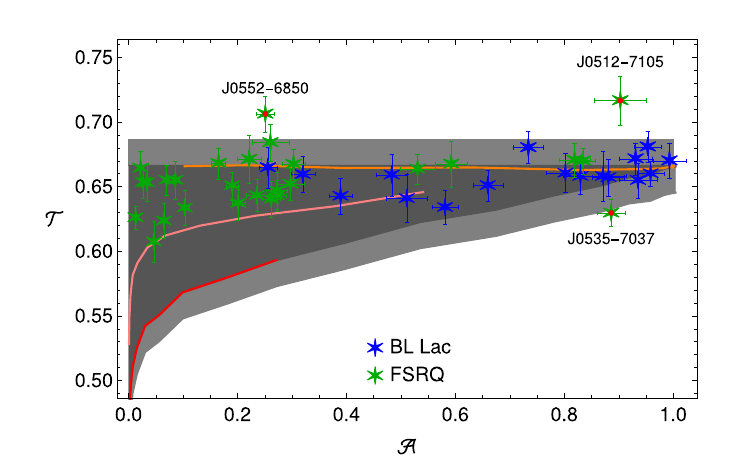Astronomy Object of the Month: 2022, January
< previous Archive next >
Newly identified blazar candidates behind Magellanic Clouds
A sample of 44 blazar
candidates behind the Magellanic Clouds, including 27 flat spectrum radio quasars (FSRQs) and 17 BL
Lacertae–type objects (BL Lacs),
were selected and described by Żywucka et al. (2018). All objects in the sample were selected based on
their radio, mid-infrared, and optical properties. Now, the analysis of the blazar candidates is extended
with modelling of optical light curves provided by the Optical Gravitational Lensing Experiment (OGLE).

Illustration 1: Large Magellanic Cloud,
one of our nearest galactic neighbours. Credit: ESO/VMC Survey.
All objects used in the study were selected from the long-term, deep optical monitoring survey, therefore they constitute a sample of faint sources with irregularly sampled optical light curves (LCs). The team investigated them to determine variability-based classification of the blazar candidates and to analyse their long-term behaviour.
The LCs were analysed with the Lomb-Scargle periodogram to generate a power spectral density for unevenly sampled time series. Alternatively, the team used the Hurst exponent to measure the statistical self similarity of a time series, and the A-T plane, to quantify the smoothness of time series by comparing the sum of the squared differences between two subsequent measurements with the standard deviation of the time series. These methods were applied to look for the blazar-like characteristic features and to study the long-term behavior of the optical fluxes.
Illustration 2 shows that the flat spectrum radio quasars (or just FSRQs) are characterized by lower values of the Abbe value, A, on the A-T plane than BL Lacs. These two classes of blazars are clearly separated on the A-T plane. This finding shows that the flux changes are different for the two blazar classes, thus they should be driven by different physical mechanisms or take place in different blazar components. The separation allowed distinguishing blazar classes based on light curves only, without including multiwavelength, polarimetric, and spectroscopic properties. Furthermore, the location in the A-T plane indicates properties in the structure of LCs which are not revealed by other methods used in this work.

Illustration 2: Locations of the blazar candidates in
the A-T plane. The dark grey area is the region between the pure PL line and T=2/3, while the light gray
regions correspond to the error bars of the simulations. FSRQs (marked by green stars) are well separated
from BL Lacs (blue stars). Credit: The Authors.
Original publication: Optical Variability Modeling of Newly Identified Blazar Candidates behind Magellanic Clouds, Astrophysical Journal, 888, 107, 2020 is the result of collaboration between the Centre for Space Research of the North-West University and the Astronomical Observatory of the Jagiellonian University (Natalia Żywucka–Hejzner, Mariusz Tarnopolski, Markus Böttcher, Łukasz Stawarz, Volodymyr Marchenko).
The research is part of research conducted at the Department of Stellar and Extragalactic Astronomy and Department of High Energy Astrophysics of the Jagiellonian University’s Astronomical Observatory (OAUJ).
|
Natalia Żywucka–Hejzner Centre for Space Research North-West University Natalia.Zywucka [at] oa.uj.edu.pl |
Mariusz Tarnopolski Astronomical Observatory Jagiellonian University Mariusz.Tarnopolski [at] uj.edu.pl |


